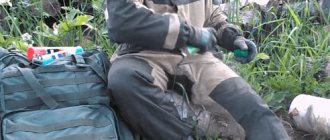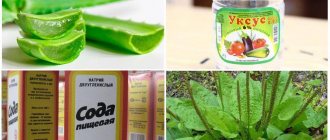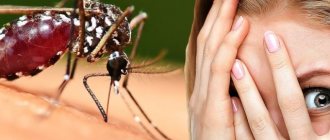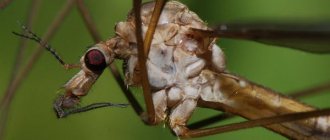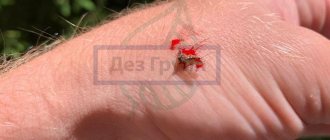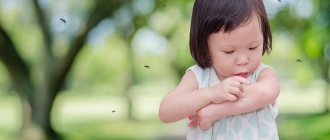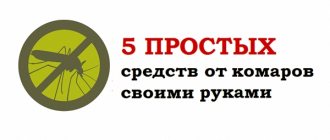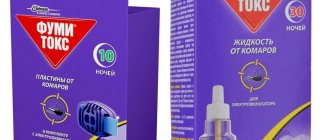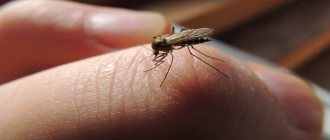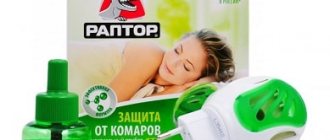The harmful effect of mosquitoes on people and farm animals is expressed in painful and uncomfortable sensations on the body after a bite, lack of quiet rest in nature and at home, and the toxic effects of saliva. Sometimes an attack by midges leads to infection of the body with infectious and invasive diseases, and in cattle - to significant loss of blood and decreased productivity.
Inflammatory and allergic reactions of the body in response to a mosquito bite occur due to irritating substances in the saliva of the parasite. These can be mucopolysaccharides, enzymes, anticoagulants and agglutinins. It is their presence that explains why the affected area of the skin itches.
In addition to the discomfort that occurs after bites, the danger of mosquitoes is associated with the transmission of pathogens of various diseases. Similar cases have been reported in different parts of the country.
:
- arboviral infections: Japanese encephalitis, West Nile fever, Sindbis virus;
- bacterial infections: brucellosis, tularemia;
- parasitic infestations: protozoal infections, filariasis.
In all dipteran insects that are included in the species composition of the midges, only females feed on the blood of humans, animals and birds. This is necessary for the successful maturation of eggs, that is, for reproduction.
What a mosquito bite looks like: photo and description
The body's reaction after an attack by blood-sucking parasites and the predisposition to allergic reactions are determined at the genetic level. According to research by scientists
, women are more attractive to mosquitoes and are more prone to acute allergic reactions.
What a mosquito bite looks like in a photo depends on many factors: the individual characteristics of the victim, the number of parasites, and the location of the bite. Facial damage can lead to serious edema in children and disrupt normal life processes. Bites on the arms and legs cause the least discomfort, provided the itching sensation is blocked.
The greatest intoxication of the body and powerful symptoms are observed with a high number of attacking blood-sucking parasites and increased sensitivity of the victim. The toxic effect of saliva in this case manifests itself most acutely in the form of local inflammatory processes and reactions of other body systems.
Symptoms
A mosquito bite is not very painful. People quickly forget about the insect attack, but soon red spots ranging in size from 2 to 5 mm appear on the body.
Some people have an allergic reaction. Allergy to mosquito bites: symptoms and best treatments.
In this case:
- spots increase in size from 7 to 10 mm;
- the bite site hurts for 24-72 hours;
- the temperature may rise to 37 degrees, which lasts for several days;
- the bite site hurts when touched;
- tissue swelling and the appearance of a rash and dermatitis are possible.
Mosquito bite: symptoms
Mosquito saliva has a toxic effect on the body of animals and humans. Red spots, swelling, puffiness, blisters, and compactions are observed on the skin. The symptoms of the manifestation depend on the species of mosquito, human immunity, tendency to allergic reactions, the degree of damage to the skin, and the number of blood-sucking parasites. The bites of malaria mosquitoes are practically not noticeable, unlike other representatives of this family. A small nodule and slight redness appear on the affected area of the skin. At the same time, if a person becomes a victim of the Aedes mosquito, within 10-15 minutes he will see:
- blister with a diameter of more than 10 mm;
- severe burning and itching;
- painful sensations;
- redness;
- when there is a high number of blood-sucking dipterans or the victim is prone to allergies - swelling and increased body temperature.
In addition to local manifestations, a mosquito bite can cause the following symptoms: deterioration in general health, increased body temperature and rapid heartbeat, changes in blood pressure and blood count (increased volume of lymphocytes and decreased number of red blood cells, hemoglobin).
Secondary manifestations of mosquito bites are local suppuration. The appearance of a secondary infection is typical when the affected area of the skin is strongly scratched with contaminated fingers or when bitten by a mosquito that carries pathogens. Cases of acute allergic reactions are less common
. Example: due to the strong effect on the body after a mosquito bite in the Komi Republic, several people were hospitalized. Severe intoxication can cause chronic glomerulonephritis.
Local inflammatory reaction
In most cases, mosquito bites lead to a local inflammatory reaction within a few minutes. The affected area of the skin experiences redness, swelling, thickening, and the person feels itching and discomfort. Sometimes blisters, necrosis, and rashes of various types form. How many hours does it take for symptoms to go away? Signs of a local allergic reaction begin to fade within 2-24 hours. In rare cases, a delayed local inflammatory reaction is observed, when symptoms can only be seen after 6-10 hours. They reach the peak of their development only after two days. Gradually, all the consequences of an attack by blood-sucking parasites disappear without any human intervention.
The most serious consequences of an attack by blood-sucking parasites can occur in patients with weakened immune systems (lymphocytic leukemia, AIDS). Their allergic reaction is severe and is characterized by an increase in body temperature and the appearance of foci of necrosis.
Severe forms of the body's reaction to mosquito bites
But there are other manifestations of a reaction to mosquito bites - papular urticaria and a systemic allergic reaction. They can occur in young children, people with hypersensitivity and intolerance to one of the components of the saliva of blood-sucking parasites.
Papular urticaria after a mosquito bite appears as itchy papules on the arms, legs, face and other exposed areas of the body. Skin formations are recurrent or chronic. Features of papular urticaria:
- develops in children 2-10 years old;
- in the first minutes after the bite, a blister with a diameter of up to 1 cm forms;
- a constantly itchy papule gradually appears;
- new rashes form sporadically;
- the disease can drag on for several years and have a chronic or cyclical course.
Systemic allergic reactions to mosquito bites are rare.
They are accompanied by local inflammation and swelling, increased body temperature, weakness, and nausea. The reason lies in the individual reaction of the body and intolerance to one of the substances contained in the mosquito’s saliva. One of the common questions and concerns people have is: “How likely is it to get malaria from a mosquito?” The spread of the disease is possible only if three conditions are met simultaneously:
- The presence of mosquitoes that carry malaria pathogens.
- Presence of parasite carriers or malaria patients.
- Optimal climate conditions (temperature and humidity) for the development of the malaria pathogen in the body of a blood-sucking parasite.
By eliminating just one factor, it is possible to eliminate the spread of malaria in the territory of the subject.
Lifespan of mosquitoes
The lifespan of mosquitoes is influenced by factors:
- sex of the individual;
- air temperature;
- humidity level;
- availability of food.
The average lifespan of males is 3 weeks, females - 2 months. At an optimal temperature of +10...+15 oC, females can live up to 119 days. At +20 °C their lifespan is reduced to 57 days, at +25 °C - to 43 days. These figures are valid if mosquitoes have access to carbohydrate food and the air humidity in their habitat is high.
Attention! At temperatures below +10 ° C, mosquitoes fall into torpor. They can remain in this state until spring. Then the time during which the insect “slept” is added to the lifespan.
What to do after a mosquito bite: drug treatment
In most cases, the strategy for action after a mosquito bite is aimed at reducing itching, redness and pain. That is, the main task is to reduce symptoms. In rare cases, professional medical attention is required. This need arises if there has been a massive attack of blood-sucking parasites, and the victim is a person prone to an allergic reaction.
To prevent severe damage to the skin and constant scratching of the damaged area, it is necessary to block the sensation of itching. For this purpose, drugs containing dimethindene maleate are suitable. This is an active substance that suppresses one of the receptors and blocks the sensation of itching. If you treat an area of skin with a preparation containing this component, the permeability of capillaries will decrease and the degree of irritation will decrease. An additional advantage of dimethindene is an analgesic and mild cooling effect.
Let's consider other features of treatment after mosquito bites:
- Antihistamines and topical glucocorticosteroid drugs are prescribed when local allergic reactions occur.
- If bullous rashes have formed at the site of the bites, aseptic opening of the blisters and their treatment with potassium permanganate are used.
- To reduce the severity of local reactions, second-generation glucocorticosteroid and antihistamine medications are used.
- Urgent hospitalization is resorted to only when systemic allergic reactions of any severity, angioedema, multiple bites, and attacks of suffocation are observed. Immunocompromised patients may require immediate medical attention.
The strategy of what to do after a mosquito bite and subsequent treatment directly depends on the clinical picture. For local manifestations, general and local therapy will be sufficient. Serious swelling and severe forms of allergic reactions require the use of more powerful drugs, which must be prescribed by a doctor.
Infection of the bite site
Due to severe itching, small children scratch the mosquito bite. A wound appears in this place, into which pathogenic microbes enter. Because of this, unpleasant symptoms intensify. Secondary infection is characterized by:
- the appearance of blisters;
- weeping wound;
- increased itching;
- increase in red spot;
- ulcers and pustules;
- release of liquid when scratching.
If infected, treatment is necessary, otherwise the bite will last a long time. The wounds will constantly become inflamed, and lumps and lumps filled with pus will appear. Local antibiotics are used for treatment: Levomekol and Tetracycline.
If secondary infection is combined with allergies, then medications should be prescribed by a doctor. He usually prescribes combination products with hormonal and antibacterial compounds. Effectively relieves inflammation Lorinden C, Fluorocort, Triakutan.
Sometimes symptoms of secondary infection occur after long-term use of hormonal drugs. Do not violate the doctor’s instructions and use them for longer than the prescribed time.
The time it takes for mosquito bites to go away depends on how accurate the therapy used is. The wound should not be scratched to prevent secondary infection from developing. If the treatment is carried out correctly, the epidermis will recover in 14 days. If the wound suppurates, unpleasant symptoms will persist for a month or longer. If the bite does not go away for a long time, you should consult a doctor.
Folk remedies for mosquito bites
To relieve itching, swelling and discomfort, you can try folk remedies for mosquito bites. They will help out if you don’t have a suitable ointment and other medications at hand:
- Essential oils help relieve itching, swelling and pain. They have anti-inflammatory, soothing, analgesic and antiseptic effects. Essential oils of lavender and tea tree will help cope with the consequences of mosquito bites. Before treating the affected skin, it is necessary to conduct a sensitivity test by dropping the solution on the elbow.
- Soda can be mixed with essential oil or water, applied to the bite site in a thin layer, or made into a cake from the resulting mixture. The product will relieve irritation and inflammation.
- Prepare a saline solution and soak a cotton pad with it generously. Apply the swab to the bite site for a few minutes.
- If a blister appears on the skin after an attack by blood-sucking parasites, a slice of raw potato will help reduce its size. For better results, it is better to grind it into a paste. This remedy is suitable for eliminating the consequences if the bite site is located in the eye area, where the use of chemical components is unacceptable.
- Parsley and cabbage leaves, crushed into a paste, help relieve itching and redness. In addition, plants improve blood circulation, reduce swelling, and have a general strengthening effect.
To reduce discomfort after a mosquito bite, any remedy that relieves itching, pain and redness is suitable. Before using it, you need to make sure that there is no allergic skin reaction to the components of the chosen folk medicine.
Types of mosquitoes
There are more than 20 species of mosquitoes. Not all of them are found in our country. People are usually worried about centipedes, squeakers, anophles and other varieties.
Let's talk about the most important of them:
- Squeaker or common mosquito. These insects are incredibly common and annoying. Females bite not only people, but also livestock. Squeaks are very dangerous because they cause discomfort in the form of itching and redness. Adult insects reach 3-8 mm. It is the females who pose the danger because they drink blood. Males use plant matter for food. Squeakers carry infections by spreading viruses. Mosquitoes carry eczema.
- The centipede lives in humid climates, mainly on the shores of water bodies or in dense forests. Insects reach from 4 to 8 mm. The largest mosquitoes known do not bite. Their diet contains juices of plant origin. These insects are completely harmless to humans, but they can cause damage to agriculture. The larvae have a great appetite.
- Malaria-type insects are dangerous because they carry parasites. Anophles usually spreads Plasmodium and malaria. The size of these pests is no different from squeaks. Mosquitoes live near bodies of water because they lay their eggs in the aquatic environment.
- The biting insect is modest in size. They are recognized by white stripes on the lower part of the body. Adult bloodsuckers spread diseases dangerous to humans.
- Winter mosquitoes are large in size. Insects settle in caves and rotten stumps because they feed on plant waste. They are not dangerous to people. Adult mosquitoes reach 20 mm. They can be found even in winter, which is why they got their name.
- The meadow mosquito lives in flooded meadows. It does not bite, so it does not pose a danger to people.
- The jerk mosquito lives in dense thickets near swamps, ponds and reservoirs. Insects often accumulate in clouds, but they are harmless to people.
- The tiger mosquito is an insect to be feared. The danger is that the bloodsucker carries typhoid, malaria, Zika virus, and Dengue fever. But in our regions they are not found.
How to protect yourself from mosquitoes
Mosquitoes interfere with a relaxing holiday not only in nature, but also at home. They enter apartments through open windows, as well as from the basement through the interior of the house - through ventilation openings and staircases. On a warm summer evening it is impossible to hide from them in the park or garden.
How can you protect yourself from mosquitoes and reduce the likelihood of being bitten?
- Avoid sweet perfumes that attract blood-sucking parasites. It is better to give preference to a fresh or sharp aroma that repels insects.
- Install mosquito nets on windows and vents.
- Apply a mixture of olive oil, clove essential oil and tea tree to your body before walking.
- Buy effective mosquito repellents and use them according to the manufacturer's instructions on clothing.
The greatest concentration of mosquitoes is observed in the evening near water bodies. If you are camping on the shore of a lake with a tent, a fire will help you escape from annoying parasites.
Life cycle of a mosquito
The life cycle of a mosquito includes 4 stages:
- Egg. After mating with the male, the female looks for a pond with standing water or damp soil, lays eggs and flies away. Each clutch can contain from 30 to 280 eggs.
- Larva. Depending on the air temperature, after 2-8 days the eggs form into larvae that look like small worms. They feed by filtering water from which they extract nutrients. About 1 liter of liquid passes through 1 mosquito larva per day.
- Doll. After about 20 days, the larvae pupate.
- Adult. An adult mosquito appears 5 days after pupation. It will be able to start reproducing within a week.
Adult insects feed on carbohydrate foods – nectar of flowers and juice of plant leaves. Decaying vegetation can serve as a food source. Only females feed on blood.
Professional mosquito treatment
If you want to get rid of blood-sucking parasites in your summer cottage, contact the Dez Group SES for help. Only professional mosquito repellent treatment will allow you to forget about discomfort and give you a relaxing holiday in nature. The company’s specialists use certified and proven drugs with a prolonged action to combat blood-sucking individuals. The effect of the insecticide is enhanced by the method of applying it using a fog generator.
If you want to clarify the cost of treating an object against mosquitoes, ask questions and find out other details of the procedure, leave a request on the company’s website. A Dez Group representative will contact you in a few minutes.
